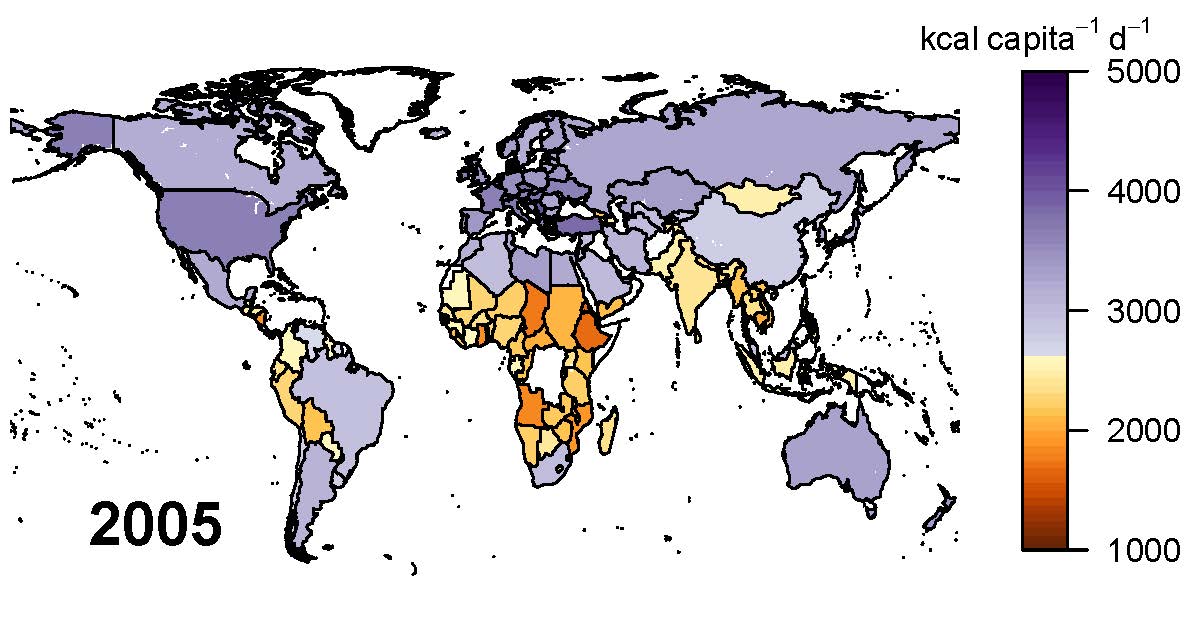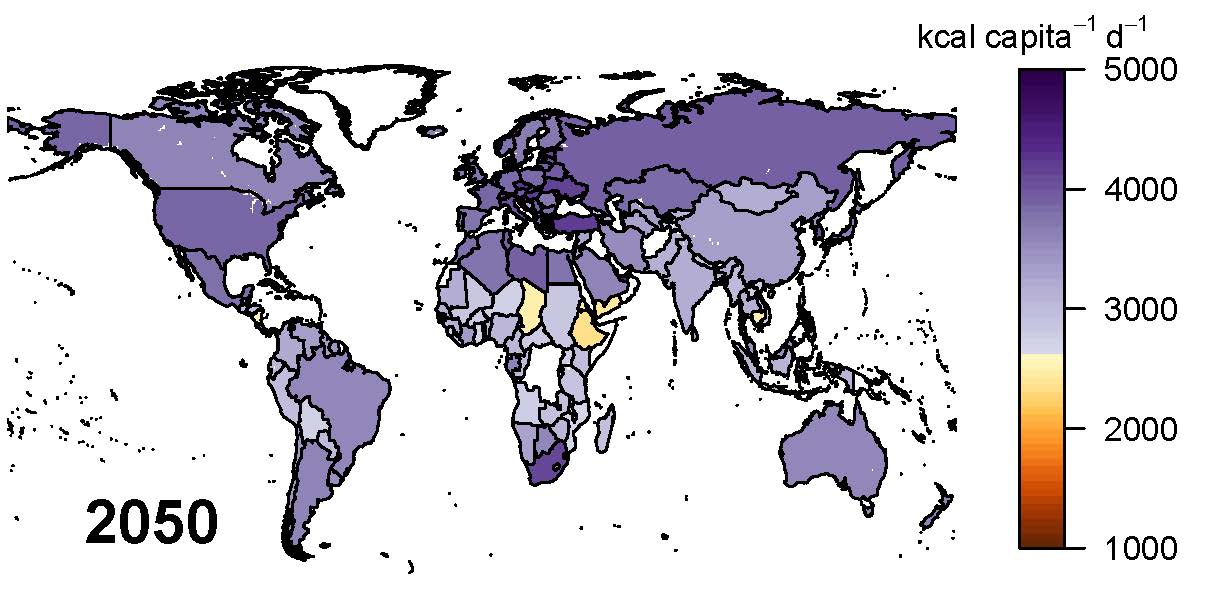Contact: Susanne Rolinski, Benjamin Leon Bodirsky
About the model
How much food will be consumed in 2050? How many people will be underweight, overweight or stunted? Will we eat more or less livestock products? How much food will be wasted? Understanding the long-term dynamics of global food demand is required to simulate long-term scenarios of the land use sector, to estimate risk factor for global health, and to estimate future environmental pressures like greenhouse gas emissions from agricultural production. Moreover, food demand scenarios can be an important tool for the analysis of future food security and human nutrition.
The Food Demand model is based on a statistical analysis of global historical data, and can be used to create long-term scenarios of household food consumption (intake and waste) for all countries of the world.
The Food Demand Model is an open-source model developed in the land use and resilience group.
Fig 1: Exemplary model results of version 2.0 as published in Bodirsky et al (2020). The map colors show the prevalence of underweight and obesity in the population. For the 16 most populous countries, symbols indicate further details on anthropometrics, dietary composition and food waste. Country abbreviations are ISO3-countrycodes. Estimates for 2050 are model projections. For 1965 and 2010, reported data is complemented with model estimates for missing data. Body mass index estimates for 1965 were complemented as reported data only starts in 1975. Dietary composition data had to be complemented for some major countries without reported data such as the Philippines or the Democratic Republic of the Congo. Food waste estimates are all model projections.
 |
 |
|---|
Fig 2: Exemplary model results of version 1.0 for the per-capita food demand in 2005 and 2050.
Have a look at the results!
A visualisation tool, designed by Kai Schefferski, can be used to have a comprehensive look at some exemplary model results. It visualizes regional food demand scenarios of model version 1.0 for the 4 SRES storylines. Please note, that while this visualization tool only features 4 scenarios on a regional scale, the model is not restricted to these scenarios, but can be used to create new scenarios, and on a country-basis.
If you prefer numbers, have a look into this Excel file.
Use it and develop it!
The food demand model is an open source project. We would be very happy if you develop the model with us! The code of the food demand model used for this publication as well as regular updates to the model can be downloaded and installed from Github (https://github.com/magpiemodel/magpie/releases/tag/v4.1.1). Additionally, the model has been archived via Zenodo (https://zenodo.org/record/3701289). Model outputs and analysis scripts used for this study as well as a guide for running the food demand model can be downloaded from https://zenodo.org/record/4034439. Regression analysis was performed using our R library mrregression (https://doi.org/10.5281/zenodo.3699647) and data input processing scripts of the R library moinput (https://doi.org/10.5281/zenodo.3699594). Standard outputs can be found in the Supplementary Material of Bodirsky et al 2020.
Please contact Susanne Rolinski or Benjamin Leon Bodirsky if you want to join the development team!
Internships and master thesis!
Are you looking for an internship at PIK or do you want to write your master thesis with us? Please contact Benjamin Leon Bodirsky or Susanne Rolinski! Also have a look at our potential topic list for master students and interns.
Versions
- Version 2.0 has been publised in Bodirsky et al (2020).
- Version 1.0 has been published in Bodirsky, Rolinski et al (2015). Archived stable versions: Model and visualisation tool. The model can be executed in the programming language R. For the creation of the storyline based projections, the R package CalorieDemand can be used. You can find the code on GitHub.
References
- Bodirsky, Benjamin Leon, Jan Philipp Dietrich, Eleonora Martinelli, Antonia Stenstad, Prajal Pradhan, Sabine Gabrysch, Abhijeet Mishra, et al. 2020. ‘The Ongoing Nutrition Transition Thwarts Long-Term Targets for Food Security, Public Health and Environmental Protection’. Scientific Reports 10 (1): 19778. https://doi.org/10.1038/s41598-020-75213-3.
- Bodirsky, Benjamin Leon, Susanne Rolinski, Anne Biewald, Isabelle Weindl, Alexander Popp, and Hermann Lotze-Campen. “Global food demand scenarios for the 21st century.” PLoS ONE 10 (11): e0139201. doi:10.1371/journal.pone.0139201. Open Access pdf.
- Milford, A.B., Le Mouël, C., Bodirsky, B.L., Rolinski, S., 2019. Drivers of meat consumption. Appetite 141, 104313. https://doi.org/10.1016/j.appet.2019.06.005
- Rolinski, S., Bodirsky, B., 2015. A new approach for estimating food calorie demand. Project report for the FAO.

 «
«



